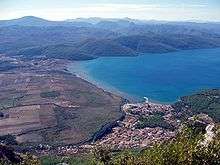Ceramus
Ceramus or Keramos (Ancient Greek: Κέραμος) was a city on the north coast of the Ceramic Gulf—named after this city—in ancient Caria, in southwest Asia Minor; its ruins can be found outside the modern village of Ören, Muğla Province, Turkey.[1]

Ceramus, initially subjected to Stratonicea, afterwards autonomous, was a member of the Athenian League and was one of the chief cities of the Chrysaorian League (Bulletin de corresp. hellén., IX, 468). In ancient times, it probably had a temple of Zeus Chrysaoreus. In Roman times, it coined its own money. Polites (Ancient Greek: Πολίτης) of Ceramus, was an ancient Olympic victor at stadion race.[2][3]
Ecclesiastical history
Ceramus is mentioned in the Notitiae Episcopatuum until the 12th or 13th century as a bishopric suffragan to Aphrodisias, or Stauropolis. Three bishops are known: Spudasius, who attended the First Council of Ephesus in 431; Maurianus, who attended the Council of Nicaea in 787; and Symeon, who attended the council in Constantinople that reinstated Photius in 879.
Ceramus is included in the Catholic Church's list of titular sees.[4]
References
- Richard Talbert, ed. (2000). Barrington Atlas of the Greek and Roman World. Princeton University Press. p. 61, and directory notes accompanying.
- Eusebius, Chronography, §80
- Pausanias, Description of Greece, 6.13.3
- Annuario Pontificio 2013 (Libreria Editrice Vaticana, 2013, ISBN 978-88-209-9070-1), p. 866
External links
- Archaeological Atlas of the Aegean
- Catholic Encyclopedia, "Ceramus" at New Advent
- Hazlitt, Classical Gazetteer
![]()